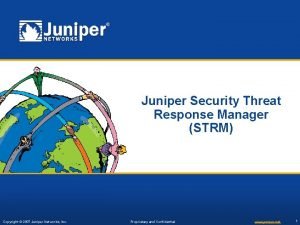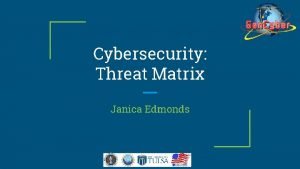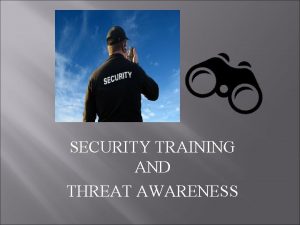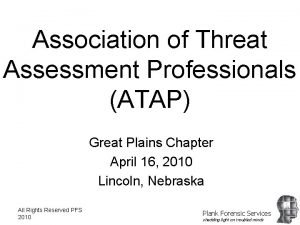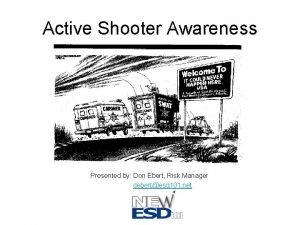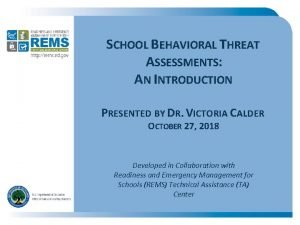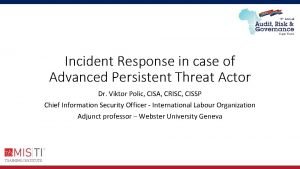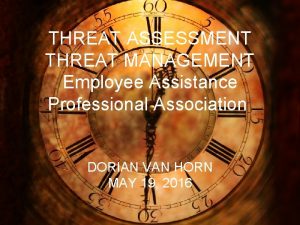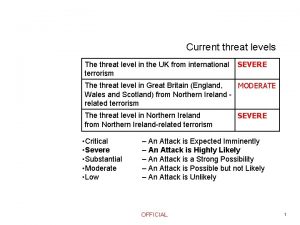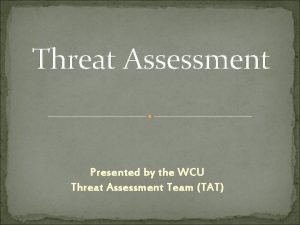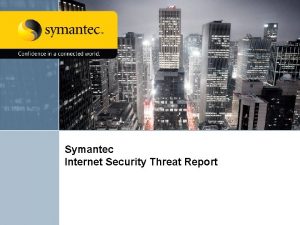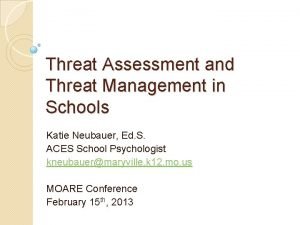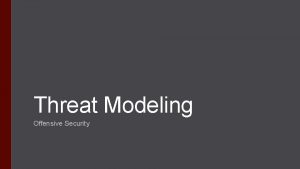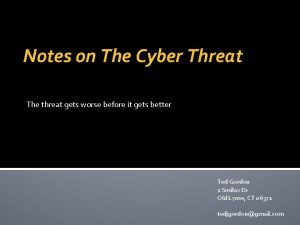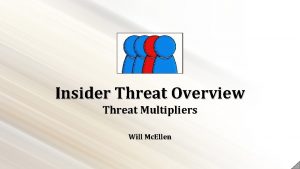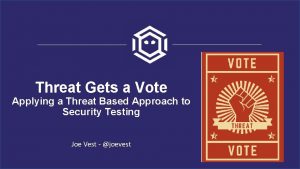ELECTION SECURITY THREAT ASSESSMENT TOWARDS 2016 GOVERNORSHIP ELECTION




















- Slides: 20

ELECTION SECURITY THREAT ASSESSMENT: TOWARDS 2016 GOVERNORSHIP ELECTION IN EDO STATE 5 th September, 2016 at Vichi Gates Hotel, GRA Benin, Edo State 1

Introduction As Edo State prepares for the gubernatorial election scheduled for September 10, 2016, the political atmosphere of the state is already charged ahead of the election that promises to be one of the most keenly contested in the history of the state. The tense political temperature is further heightened by the inflammatory utterances of the major candidates as well as reported cases of attacks and counter-attacks on their campaign convoys. In this analysis, the risk factors that may threaten public peace and security during and immediately after the election are examined as well how they can be checked or de-escalated. The preparations by the Independent National Electoral Commission (INEC) and security agencies are highlighted as well as recommendations on how to ensure a free, free and conclusive election in Edo State. 2

RESEARCH ANALYSIS AND FINDINGS Methodology The procedure of producing the pre-election risk assessment report for the 2016 Edo state gubernatorial election was hinged on the election risk assessment protocol and instrument developed by the Electoral Institute of INEC. These can be broadly classified into two; 1. Field work: • Recruitment and training of field workers • The population was stratified into two, the general public (Nigerians of voting age) and the experts (Nigerians of voting age with expertise in the electoral process) • Carried out field work in the 18 LGA in the state • A margin of error of 3. 5 and confidence level of 95% was used for this research. • A total of 783 respondents were sampled. • The data entry and analysis were done using Statistical Package for Social Science (SPSS) and Excel 2. Informant Interviews, (KII) media reports etc. 3

GENERAL PUBLIC RESPONDENTS BY SEX Missing 0% Female 32% Male 68% 4

Expert Respondents by Sex 5

For General Public Respondents Q 1. Do you agree that election in this area will be peaceful? 38. 3 Percent 32. 4 13 9. 6 6. 1 0. 5 Strongly Agree Undecided Disagree Strongly Disagree missing 6

For Experts Respondents 7

Key Findings from the Research • RED: Oredo, Egor, Igueben, Esan- Central, , Etsako-West, , Orhiorwon. • AMBER: Etsako East, Esan West, Esan South, Ovia South-West, Etsako-Central, Akoko Edo • GREEN: Esan-North East, Owan-East, Ikpoba- Okha, Ovia North Ease, Owan West, Uhunmwode. 8

Tables showing Identified Hotspots from the EVMT Field Work 9

Tables showing Identified Hotspots from the EVMT Field Work 10

PEACE OR VIOLENCE? : A COMPRATIVE ANALYSIS OF LOCAL GOVERNMENT AREAS. 11

12

13

14

15

16

Synthesis of Key Risk Factors • The role and activities of security agencies: The role of security agencies in securing the election remains a risk factor. Although several police and other security personnel will be deployed to Edo state during the election, the need for them to be non-partisan cannot be over-emphasised as it could be a trigger for violence. • Early deployment of INEC staff and materials: INEC should ensure that election personnel and logistics gets to the riverine areas on time. This will reduce the waiting period before accreditation and voting can commence. • Hate and inciting speech: The build up to the Edo State Governorship Election has witnessed intensive campaigning especially between the ruling All Progressives Congress (APC) and the main opposition, the Peoples’ Democratic Party (PDP). However, with the intense campaigning has also come intense use of hate and inciting speech. These have featured on campaign ground, traditional and social media. These unguarded statements by politicians can heat up the polity, incite violence and jeopardize the peaceful conduct of the elections. 17

Synthesis of Key Risk Factors continued • • • Political/Youth Violence: The violence recorded in the electioneering process where attributed to the activities of party thugs. For instance in Etsako West L. G. A, campaign bill boards of the APC and PDP were destroyed and the acts were alleged to be carried out by the political thugs of each party. There were also attacks on political party candidates convoy etc. In addition, there is a proliferation of thugs in Edo State. The increasing poverty, unemployment and youth exclusion has only exacerbated the problem. Many of these youth are exposed to drugs, small and light weapons and are susceptible to manipulation and may likely used as party thugs. Fear of Electoral manipulation: – Vote rigging or perceived rigging will be a major trigger of violence during the gubernatorial election. INEC should ensure a level playing ground for all the political parties involved in the election. Staff welfare and training for INEC staff: The Commission should guard against last minute switching of ad-hoc staff which hampers the smooth running of elections. Collection of PVCs: The huge number of uncollected PVCs remains a challenge for the election. About 400, 000 PVCs remained uncollected few days before the election which is a big issue for a voting population of less than two million. Public enlightenment should be sustained: The level of illiteracy and lack of awareness is high in some of the areas covered and may likely impact negatively on the election. 18

CONCLUSION • The Edo State governorship election comes up on 10 th September 2016. The aggregate data appear to suggest that the election will overall, be peaceful. However, when some questions are broken down and examined in the context of particular local governments, the picture that emerges is one that enables us to classify the potential for violence during the elections within certain locations. The history of elections in the state may also provide some bearing here. In a sense, the electoral domains of some party chieftains as well as known party enforcers who have turned electoral violence into a business proposition. These election violence entrepreneurs are mostly to be found in urban areas. The ready availability of able -bodied young men and women who are very much idle may constitute a recruiting ground for desperate politicians who may insist on having their way at all costs in the forthcoming elections. What is to be done? We have proffered some suggestions below. 19

RECOMMENDATIONS • • • In identified areas with potential for violence or habitual violence, security agencies should act proactively by inviting the electoral violence entrepreneurs in these domains for pre-emptive chats. The security agencies should have intelligence units that monitor the behaviour of security agents deployed for election work. Such units should be able to make reports real time and also get responses as the election is ongoing. Civil society observer teams should not just observe and report, but should have real time mechanism in place for connecting field observations to those who have the capacity to correct polling-unit error or intervening to put volatile situations under control. A conscious awareness, and constant reminders of electoral violence triggers on the part of INEC staff, security agencies and civil society organisations, with a view to nipping in the bud any time that raise their heads. Special attention should be paid to ensure timely arrival of election materials and personnel, and timely commencement of the voting exercise. 20
 Microsoft threat modeling tool 2016
Microsoft threat modeling tool 2016 Privatesecurity
Privatesecurity Juniper security threat response managers
Juniper security threat response managers Cyber security threat matrix
Cyber security threat matrix Climate change national security threat
Climate change national security threat Suspicious packages training
Suspicious packages training Stalker
Stalker Don ebert
Don ebert Behavioral threat assessment software
Behavioral threat assessment software Advanced persistent threat assessment
Advanced persistent threat assessment Employee threat assessment
Employee threat assessment Sql server 2016 security features
Sql server 2016 security features Word 2016 session 2 post assessment
Word 2016 session 2 post assessment Osi security architecture model with neat diagram
Osi security architecture model with neat diagram Guide to network security
Guide to network security Wireless security in cryptography and network security
Wireless security in cryptography and network security Visa international security model
Visa international security model Electronic mail security in network security
Electronic mail security in network security Cnss model 27 cells example
Cnss model 27 cells example E commerce security meaning
E commerce security meaning Building security software
Building security software


